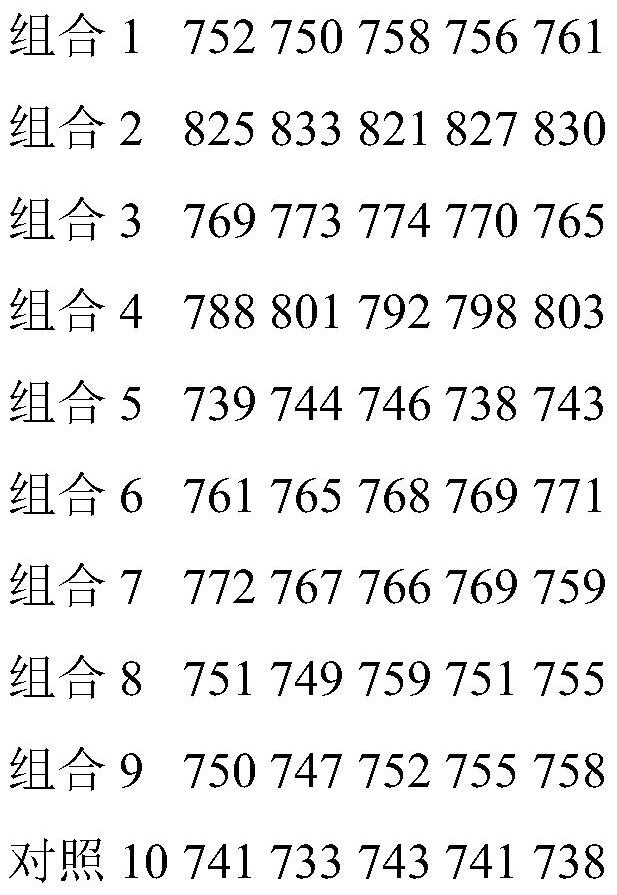A kind of composite photorespiration inhibitor and its preparation method and application
A photorespiration inhibitor and composite technology, applied in the field of plant biology, can solve problems such as affecting the efficiency of photosynthesis, and achieve the effects of improving the net photosynthetic rate, increasing the accumulation, and being easy to operate.
- Summary
- Abstract
- Description
- Claims
- Application Information
AI Technical Summary
Problems solved by technology
Method used
Image
Examples
Embodiment 1
[0017] Sodium bicarbonate with a concentration of 50mg / L~500mg / L, sodium bisulfite with a concentration of 50mg / L~500mg / L, choline chloride with a concentration of 50mg / L~500mg / L, and a concentration of 0.5%~ 1.5% Tween-80 is configured as a mixed reagent, and sprayed once 10 days before the flowering period, 10 days after the flowering period, and the fruit expansion period, and sprayed on the leaves of the plant carefully, and the control is sprayed with water . The photosynthetic rate was measured 20 days after flowering, and the yield and total sugar of the fruit were measured at the ripening stage of the fruit.
[0018] In this example, 9 compound photorespiratory inhibitors were designed according to different concentrations. Wherein, the concentration design of Tween-80 is 1.5% (A1), 1.0% (A2) and 0.5% (A3); The concentration design of sodium bicarbonate is 500mg / L (B1), 300mg / L (B2) and 100mg / L (B3); the concentration design of sodium bisulfite is 500mg / L (C1), 300m...
Embodiment 2
[0030] Each combination and control group in Example 1 were used to carry out the spraying experiment. In the spring of 2016, in a certain orchard in Dalian Economic and Technological Development Zone, 50 "Meizao" cherry trees (1 strain as one) were selected for 10 years of life and the growth was basically the same. Repeat), 10 days before their flowering stage, 10 days after the flowering stage, and around 4:00 p.m. Be careful when spraying. The photosynthetic rate was measured 20 days after flowering, and the yield and total sugar of the fruit were measured at the ripening stage of the fruit. The photosynthetic rate was measured by a photosynthetic rate meter, and the total sugar of the fruit was determined by anthrone colorimetry. The experimental results were statistically analyzed by means of analysis of variance.
[0031] 1. Yield per unit area (kg / 666.67m 2 )
[0032]
[0033]
[0034]
[0035] Conclusion: Combination 2 has the highest fruit yield per unit...
Embodiment 3
[0048] In the spring of 2017, continue to test on the tree of embodiment 2. The number of plants and the number of repetitions are the same as in Example 2. 10 days before their flowering period, 10 days after the flowering period, and around 4 o'clock in the afternoon during the fruit expansion period, the compound photorespiratory inhibitor was sprayed once, and the control was sprayed with water. Each treatment was repeated 5 times. Be meticulous and thoughtful. The photosynthetic rate was measured 20 days after flowering, and the yield and total sugar of the fruit were measured at the ripening stage of the fruit. The photosynthetic rate was measured by a photosynthetic rate meter, and the total sugar of the fruit was determined by anthrone colorimetry. The experimental results were statistically analyzed by means of analysis of variance.
[0049] 1. Yield per unit area (kg / 666.67m 2 )
[0050]
[0051]
[0052]
[0053] Conclusion: Combination 2 has the highe...
PUM
 Login to View More
Login to View More Abstract
Description
Claims
Application Information
 Login to View More
Login to View More - R&D
- Intellectual Property
- Life Sciences
- Materials
- Tech Scout
- Unparalleled Data Quality
- Higher Quality Content
- 60% Fewer Hallucinations
Browse by: Latest US Patents, China's latest patents, Technical Efficacy Thesaurus, Application Domain, Technology Topic, Popular Technical Reports.
© 2025 PatSnap. All rights reserved.Legal|Privacy policy|Modern Slavery Act Transparency Statement|Sitemap|About US| Contact US: help@patsnap.com



